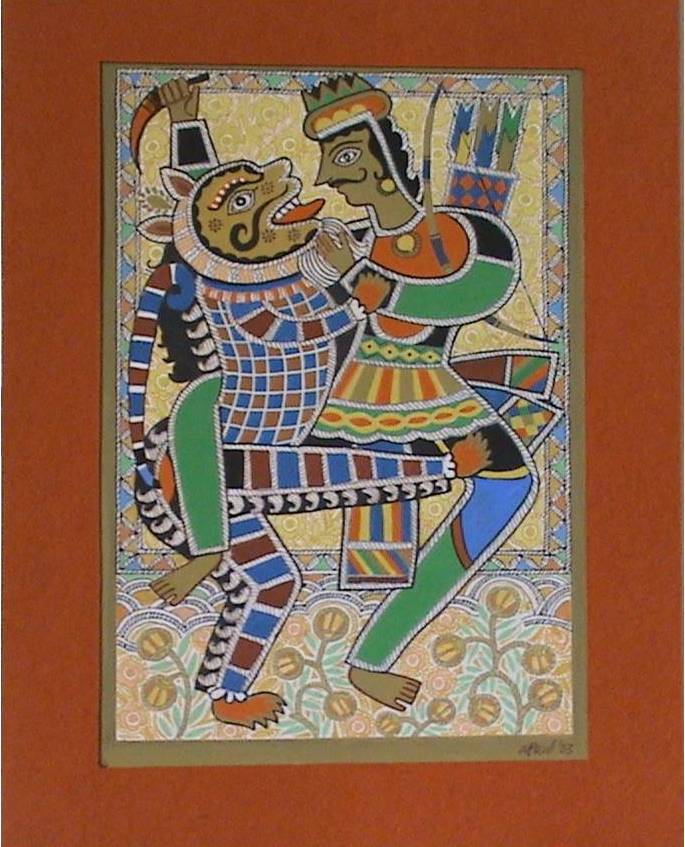
Are you a hardcore Indian art lover? Do you like to visit places which embark historical remains of earlier civilizations? If you have visited different museums or browsed any online art gallery, you would notice a genre called “Madhubani paintings”. India has an enormous history of tribal paintings, out of which Madhubani paintings are appreciated the most. This art has inspired artists all around the world because of the use of vibrant and attractive colors. Tourists are overwhelmed by the paintings and pay a visit to India to add these paintings to their art collections or they buy such paintings if they are available in an art gallery online. This has unlocked a new world for art style globally.
Madhubani paintings are also known as Maithili and Chitra paintings. The origination of Maithili paintings is assumed to be around the time of Ramayana. But the major tradition of Madhubani paintings began with its themes based on domestic rituals in Bihar. Initially, these paintings were created for a welcoming gesture to Gods as people of Bihar believe that Gods visit their houses to give them a boon of luck and prosperity. Thus, they hung Madhubani paintings to decorate the walls, doors and floors. Later, around 1964, Madhubani paintings stopped being just an ornamental art and got commercialized so that there could be other sources of revenue. The designs shifted from walls and floors to paper, sarees, satin, etc. and still sustain to be a mode of income for many.
The compositions always revolved around stories of religion and mythology. Themes of Lord Krishna and his lady love Radha are depicted in most of the paintings. Some artists indulge in illustrating scenes from lives of Maa Durga, Shiva-Parvati, Ganesha and other deities. Still, Madhubani paintings are not devoid of natural sceneries from everyday life such as villages, flowers and animals. This has led to these paintings being a significant part in all cultural and religious events and festivals which take place in Bihar and other parts of the nation.
These paintings are a source of social relations for women in Bihar as they generally work on these paintings in a group. They create these paintings by laying inefficient skills, ideas and desires. The main reason why this traditional art has survived through the centuries is the hard work and spirituality of these women. Government has even supported these women in booming up their sales of traditional paintings and helping them earn for bread and butter.
The prominent aspects which are employed in Madhubani paintings are as follows:
- These paintings are characterized by the colors which are incorporated in the paintings. Very bold and prominent colors like yellow, blue, green, pink, red, black and white are used in Madhubani paintings. These are either natural or artificial colors made of minerals, plant extracts or pure chemicals which are now available extensively in markets.
- Cow dung was often used in the beginning for plastering the canvas. Then these paintings included double borders which sustained geometric structures or sometimes floral decorations. Sometimes these borders were drawn with bamboo twigs whose ends were worn out.
- Figures of deities and from nature were very elaborated and showed colorful radiance. Sometimes, they depicted in the form of abstraction. Faces were shown with large and bulging eyes and noses were abruptly out of the forehead.
A very talented and creative Madhubani artist, Jagdamba Devi was given an award by President of India in 1970 for her exceptional works. This finally gave official recognition to Madhubani art. Later on, National Awards were given to many other artists like Sita Devi, Godavari Dutt, Bua Devi etc. Recently in 2013, Smt. Bharti Dayal was also reputed with Indira Gandhi Priyadarshini Award for her respectable and astonishing works of Madhubani art and has been globally acclaimed. Madhubani paintings continue to be an active Indian paintings which is now widely celebrated and can be seen exhibited on any online art gallery.





















